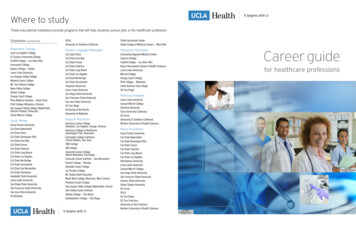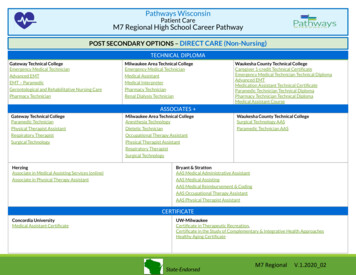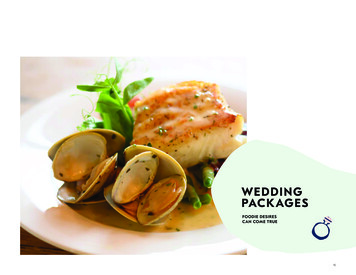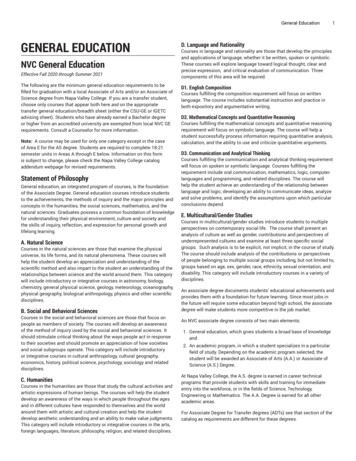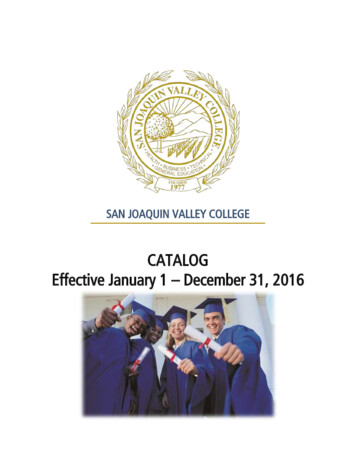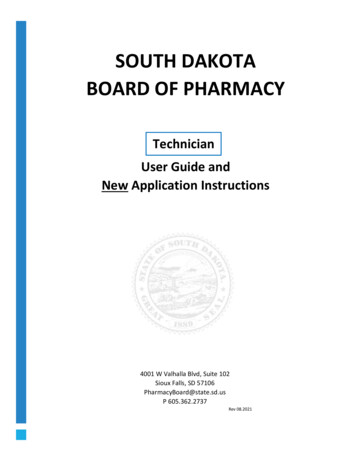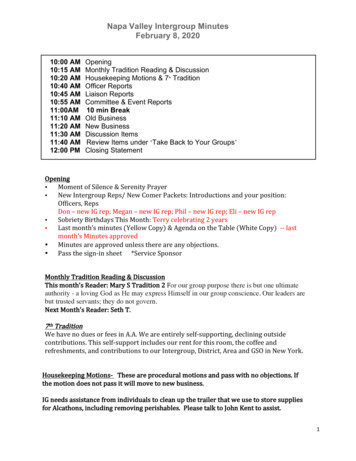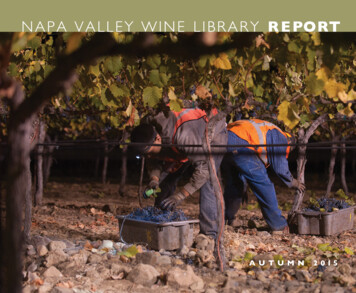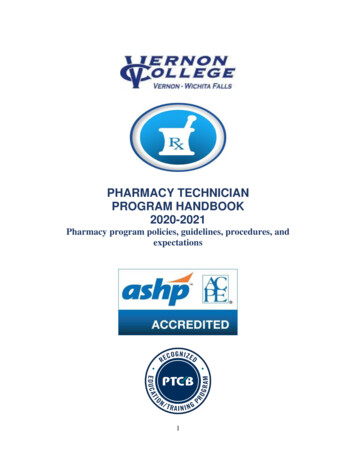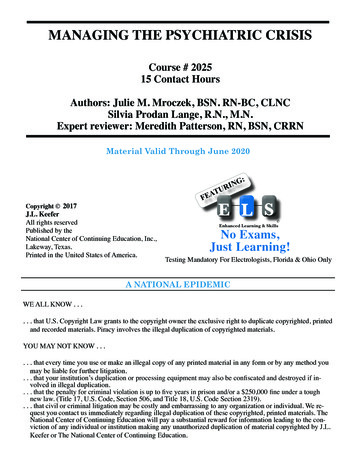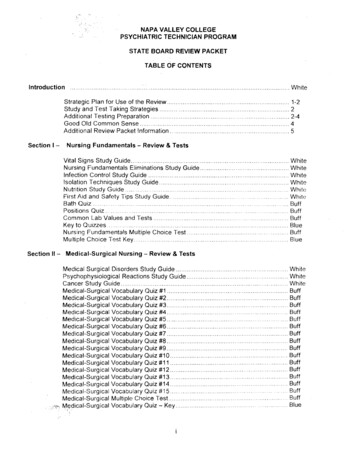
Transcription
NAPA VALLEY COLLEGEPSYCHIATRIC TECHNICIAN PROGRAMSTATE BOARD REVIEW PACKETTABLE OF CONTENTSIntroduction . :. WhiteStrategic Plan for Use of the Review . 1-2Study and Test Taking Strategies . . . . . 2Additional Testing Preparation . 2-4Good Old Common Sense . 4Additional Review Packet Information. . 5Section I -Nursing Fundamentals - Review & TestsVital Signs Study Guide . WhiteNursing Fundamentals Eliminations Study Guide . WhiteInfection Control Study Guide . WhiteIsolation Techniques Study Guide. . . WhiteNutrition Study Guide. . . . . . . . . . . . . . . . . . WhiteFirst Aid and Safety Tips Study Guide. . . . . . . . . . . . . White. . . . . . BuffBath Quiz. . . . BuffPositions Quiz. .Common Lab Values and Tests . . . . BuffKey to Quizzes . Blue. BuffNursing Fundamentals Multiple Choice Test . . . .Multiple Choice Test Key. . . . . BlueSection II -Medical-Surgical Nursing - Review & TestsMedical Surgical Disorders Study Guide . WhitePsychophysiological Reactions Study Guide . WhiteCancer Study Guide . WhiteMedical-Surgical Vocabulary Quiz #1 . BuffMedical-Surgical Vocabulary Quiz #2 . BuffMedical-Surgical Vocabulary Quiz #3. Buff. . BuffMedical-Surgical Vocabulary Quiz #4. .Medical-Surgical Vocabulary Quiz #5. . . . BuffMedical-Surgical Vocabulary Quiz #6. . BuffMedical-Surgical Vocabulary Quiz #7 . BuffMedical-Surgical Vocabulary Quiz #8. . . BuffMedical-Surgical Vocabulary Quiz #9 . BuffMedical-Surgical Vocabulary Quiz #10 . BuffMedical-Surgical Vocabulary Quiz #11 . BuffMedical-Surgical Vocabulary Quiz #12. . Buff. BuffMedical-Surgical Vocabulary Quiz #13. .Medical-Surgical Vocabulary Quiz #14. . BuffMedical-Surgical Vocabulary Quiz #15. . BuffMedical-Surgical Multiple Choice Test. . Buff. . BlueME;dical-Surgical Vocabulary Quiz - Key. . . .
Section V - Pharmacology - Review & ExamsPharmacology Study Guide . WhiteNeedles & Syringes Study Guide . WhiteMedication Administration Routes Quiz . BuffOral Medications Quiz . BuffCommon Abbreviations Quiz . . . . . BuffConversion Quiz . BuffKnow Your Medications Quiz #1 . BuffKnow Your Medications Quiz #2 . BuffKnow Your Medications Quiz #3 . BuffKnow Your Medications Quiz #4. BuffConversion Problems . BuffConversions Quiz . BuffQuizzes - KEy . BlueKnow Your Own Medications Quizzes - KEy . BlueKey-Conversion Problems Key . BluePharmacology Multiple Choice Test. . BuffPharmacology Multiple Choice Test - KEY . Blueiii
Napa Valley CollegeHealth OccupationsPTEC ProgramINTRODUC1"'ONThe purpose of this packet is to guide the selection of content and behaviors to be reviewed before takingthe licensing examination. You have been prepared with knowledge of: Maintenance and Promotion of HealthThe Nursing ProcessManagement of Safe and Effective Client CareClient's Physiological NeedsClient's Psychosocial NeedsThe following elements are integrated in the above knowledge base. Mental Health ConceptsStructure and Function of the Human BodyPathophysiologyPrinciples of AsepsisRecord keepingCommunicationGrowth and DevelopmentNutritionPharmacologyPatienUFamily TeachingProfessional AccountabilityYOll will need 10 review other content areas including: Client's RightsConfidentialityInfectious Agents and Immunity ProcessActivity of Daily Living and Routine Nursing MeasuresSafety MeasuresModalities of TreatmentContinuity of CareEmergencies and Crisis CareHuman SexualityResponse to TherapiesGroup DynamicsPsychodynamics of BehaviorLeadership and Case ManagementCultural and Religious EffectsSTR.ATEGIC PLAN FOR USE OF THE REVIEWReview the objectives and your notes for each of the modules you have completedcourse of study.2.Review the outlines, vocabulary and tables included on each orthe studyinformation is essential for mastery of each subject.1guide a'Sduri thiSthis
NAPA VALLEY COLLEGEPSYCHIATRIC TECHNICIAN PROGRAMSTATE BOARD REVIEW PACKETThis packet is designed so the graduate can evaluate his/her knowledge during the course of study in thepsychatric technician program. These are NOT actual test items that will be found on your licensingexam. Directions for using this packet are as follows:1.Take each test, using a sheet of paper to record your answers. This will allow you to use the testagain without having the answers already marKed.2.On completion, check your answers with those on the blue answer sheets.3.Identify areas of deficiencylweakness by outliningllistening them on the back of your answersheet.4.In following the above steps for each section of the packet you will evaluate your needs and beable to review in order to correct any problem areas.5.Use your modules, textbooks and any other reference material that will be of assistance to you.5
SECTION INURSING FUNDAMENTALSREVIEW & TESTS
STUDY GUIDEVITAL SIGNSI.II.II\,TemperatureA.Oral98.6 degrees F. (37 degrees Centigrade)B.Rectal99.6 degrees F.C.Axillary97.6 degrees F.Pulse: Taken at an artery site. not a vein siteA.Rate1.Fetus: 120 -- 1602.Newborn: 130·1403.Adult: 1.a.heart rate above 100 beats per minutebradycardia2.a.heart rate below 50 beats per minuteRespirationsA.Adult: 16 - 20B.Newborn: 30 - 40C.Terms1.apneaa.absence of respiration2.dyspneaa.difficulty breathing3.orthopneaa.difficulty in breathing in positions other than stnading or sitting (seen inCHF)4.Kussmula.labored gasps in respiration of increased rate and depth. Associatedwith diabetic coma5.Cheyne-Stokesa.alternation of cycles of increasingly rapid and deep respiration's withperiods of apnea that vary in length (often seen just before death)Blood PressureA.Systolic: First Beat Heard1.Adult90 -- 145 mm (average 120)2.Child90 -110 mm (Child of 5 years of age)B.Diastolic: Last Beat Heard1.Adult 60 - 902.Child60 - 80 (Child of 5 years of age)C.Terms1.Pulse pressurea.difference between the systolic and diastolic(eg: Bp:: 120/80 therefore pulse pressure is 40) ",4\\,\1
2.3.4.5.(1)increased pulse pressure seen in head injury(2)increased intracranial pressureHypotensiona.decreased blood pressure (eg: 90/60, 70/50)Hypertensiona.increased blood pressure (eg. 145/90, 180/110,200/120)Orthostatic hypotensiona.decrease in blood pressure when coming to a standing position(frequently seen as a response to Thorazine and Melleril)BP positionsa.lying or supineb.sitting or uprightc.these measures try to asses orthostatic hypotension2
STUDY GUIDENURSING FUNDAMENTALSELIMINATIONSI.II.UrineA.Catheter1.a tube for evacuating or injecting fluidsCatheterizationB.1.introduction of a tube into the bladder to remove urine (via urethra or suprapubic)PurposesC.1.empty the bladder before surgery or childbirth2.keep bladder decompressed during certain surgical procedures3.empty the bladder and prevent distention after surgery or delivery when theindividual cannot void4.relieve urinary retention by gradual decompression (REMEMBER: Never drainmore than 1OOOcc at one time)5.to measure the amount of residual urine6.intennittently drain and irrigate bladder7.instill medications8.for incontinence in certain clients9.rarely, to obtain a sterile specimenPotential problems related to catheterizationD.1.infections2.trauma to tissueCatheter CareE.1.gravity drainage, therefore:a.keep the bag below the level of the bladder at all timesb.keep the tubes from kinkingc.never clamp without an order2.infection preventiona.never disconnect the tubing without an orderb.never let the bag touch the floorc.peri-care is essential3.Intake and Outputa.usually q shift (8hours) but can be done more frequently, especially inthe case of critically ill individuals4.unless contraindicateda.encourage fluidsBowel CareA.Stool tenns1.feces2.fecalitha.a fecal concentration3.description of feces in chartinga.amountb.consistencyc.colord.odor, when unusual4.diarrheaa,frequent stools of fluid consistency5.constipationa.infrequent passage of hard, dry stool6.impactiona.feces is tightly wedged in bowel. Often the patient will pass loose liquidstool around the impaction3
7.flatusa.gasTreatment1.Enemasa.oil retention(1)softens hard feces for easy evacuationb.fleets(1)gentle enemac.soap suds(1)irritating enemad.saline enema(1)salt enemae.tap water enema(1)do not give more than 1000cc at a time2.Harris flusha.also known as retum flow enemab.stimulates peristalsis and removes passage of gas3rectal tubea.removes gasCollection of SpecimensA.Urine1.Simple voided specimena.used for Uab.use clean container2.Clean catcha.midstream, urine for culture and sensitivities(1)cleanse perineum(2)begin urine stream. Initial urine will cleanse urethra of bacteriaDiscard this initial urine(3)catch the midstream urine in a STERILE container3.Fractional urine'sa.used for testing of sugar and acetoneb.before breakfast, lunch, dinner. and H.S.c,"spilling" of sugar assesses, ketones assessed4.Second voided specimena.used often in fractional urines, a second voided specimen is a betterindication of the body's status at the time of the voidingB.Bowel1,stool for occult blooda.guiac2.stool for ova and parasitesa.must be kept warm to keep the "bugs" alive so the lab can discover themb.take to lab immediatelyBIII.4
STUDY GUIDEINFECTION CONTROLI.Nosocomial Infections: those that are hospital inducedII.Asepsis: free of pathogenic organismsA.Medical Asepsis: techniques used to inhibit the growth and multiplication of pathogenicorganisms, and to prevent the transfer of pathogenic organisms from one person toanother1.handwashinga.the single most effective practice of medical asepsis and infectionprevention2.Isolation techniquesa.a system of barriers designed to inhibit cross-contamination3.B.Disinfectiona.destroys pathogenic organisms. but not their sporeSurgical Asepsis: techniques used to kill microorganisms and their spores1.autoclave (steam under pressure)2. h eneo degas3.procedures performed under surgical asepsisa.urinary catheterizationb.dressing changesc.injectionsd.surgery5
STUDY GUIDEISOLATION TECHNIQUES TYPE OF ISOLATIONRespiratoryINDICATIONS FOR USESETUPPathogens transmitted byairbourne routePulmonary TBRubella, Chicken Pox1.2.3.4.EntericYV()11J}(Land SkinStri ;tReverse ([:!rotective}Pathogens transmitted throughdirect or indirect contact withfecal material (really any contactwith gastro-intestinal materials)Hepatitis A, BSalmonellosisGastroenteritisPathogens transmitted by directcontact with lesionWound infectionsImpetigoPathogens highly communicablethrough direct contact andairbourne routesStaph. PneumoniaRabies, plaguePathogens from environmentpose threat to client with .4.Private roomMasks for personnel andvisitorsMask for client whentransportingSpecial handling of sputumand contaminated tissuePrivate room and bath bestGown and glove whentouching client or things inroomDouble bag linens andobjects used by clientSpecial needle and syringeprecautions with Hepatitis A(and B, too)2.Gown and glove when indirect contact with patientDouble bag articles that havebeen in direct contact withpatient1.private room with door closed1.2. gowns, gloves, and masks3.1.2.3.4.for personnel and visitorsspecial handling of all articlescoming from roomprivate room with closed doorLaminar Air-flowSterile supplies and linensSterile gowns. gloves, masksfor personnel and visitors. 6
STUDY GUIDENUTRITIONI.II.III.ProteinsA.Amino acidsB.Building blocks of the bodyC.4 calories per gramD.Sources1.meats, poultry, fish, eggs2.milk3.legumes4.breadsE.Disorders1.PKU - inability to metabolize phenylalanine2.Kwashiorkor starvation - (poor intake and/or utilization of protein)FatsA.TriglyceridesFunctionB.1.storehouses of energy, spares the metabolism of protein when carbohydrates aredepletedC.TypesSaturated1.a.whole milkb.ice creamccheeses made from whole milkd.egg yolke.fatty meats (beef, pork, ham, urateda.vegetable oilb.mayonnaisec.special margarinesd.fatty fish (salmon, tuna, herring)3.Cholesterola.egg yolksb.liverc.sweet breadsd.whole milke.ice creamf.cheeseg.butterD.9 calories per gramE.Fat disorders1.high serum cholesterol coronary heart2.occlusion of arteries]3.gallstones are almost completely cholesterol4.cancer of th colon and breast have been corollated with high faHy intakeCarbohydratesA.Energy providerB4 calories per gramC.Sources1.cereal2.grains and breads3.fruits and vegetables7
IV4.milk5.sugar and sweetsD.Disorders1.obesity2.dental % in bones and teethB.Phosphorus180% in bones and teethC.K or potassium1.found inside the cells of the bodyDNa (sodium1in fluids outside of the cell bodyU*"" Remember: High intake of sodium (salt) leads to edema and forms of water retention.Hypertension, CHF. Restrict NaC1E.Iron1.2.builds hemoglobinsourcesa.liverb.organ meatsc.egg yolksd.peanut buttere.spinachf.prunesg.whole grain breads. Remember: There is no iron in milk!! Children must be provided an early iron source. Usually eggyolks3.Disordersa.various forms of iron deficiency anemiasV.Vitamins: See the chartV.Basic 4A.Milk group2 cups for adults1.2.2 - 3 cups for children under 93.3 - 4 cups for children 9 -124.3 or more cups for pregnant women5.4 or more cups for lactation (breast feeding mothers)B.Meats: 2 servings each day1.2 - 3 ounces lean, cooked beef. veal. pounry, fish22 eggs3.1 cup 01 cooked dry beans,peas. lentils4.4 tablespoons of peanut butterCVegetables and Fruits: 4 or more servings1.1 serving of citrus fruits or other high Vitamin C fruits2.1 serving of dark green or deep yellow vegetables3.2 other vegetables and fruits (including Irish potatoes)D.Breads and Cereals: 4 or more servings each day1.1 slice whole grain, enriched bread2.1 ounce of ready to eat cereal3.y, to o/.c cups cooked cereal, corn meal, macaroni, noodles, rice or spagetti8
VITAMINS: Chemical compounds of an organic nature that occur in minute quantities in food. They arenecessary for the growth and regulation of bodily processes.minFat soluble (more readily stored in the body. Excessive amounts can be dangerous)FunctionSourceDefi.cienc Y State.---1Develops structure of bonesand teeth.Healthy skin and mucousmembranes.Vision in dim light.Carrots!!Egg yolks, liverMilkNight blindness. blindnessEye infectionsLowered resistance toinfectionDrying and scaling of skinFunctions as a hormone inabsorption of calcium andphosphorus. Calcification ofbones and teeth.Fortified milkSunlightRickets:Soft bones, enlarged jointsEnlarged skullSpinal curvatureBowed legsEProtects breakdown of RBCsProtects against destructionof Vitamin A.Salad oil. margarineNuts. legumesDark leafy vegiesNo currently identifieddeficiency stateKFormation of prothrombin fornormal blood clotting.Synthesized in intestinesby bacteria action.Dark green vegetablesHemorrhage especiallynewbornC (absorbicacid )Resistance to infectionsPromotes wound healingKeeps teeth firm in gumsResistance to colds and flu?Citrus fruitsStrawberriesTomatoesGreen veggiesScurvy:Bruising. hemorrhageBleeding gumsLoose teethThiamineVitamin 8,Healthy nervesGood digestion and appetiteGood mental outlookLiver, beansPeanut butterEnriched breadsNeuritis of legsFatiguePoor appetiteBeriberiPolyneuritisEdemaHeart failure··Alcoholic neuropathyNiacinEnergy and metabolismHealthy skinMeat. poultryEnriched breadsPellegra:DermatitisSore mouthDiarrheaFolic acidMaturation of R8CsSpinachMeatsEnriched breadsMacrocytic anemia ofpregnancyCobalamine(Vit 8 12 )Intinsic Factor neededFormation of strong R8CsAnimal foods only(meats and eggsmilk, fish)REMEMBER: Intrinsicfactor which is found inthe intestines is neededto absorb the Vitamin8 12 from any dietaryintakePernicious anemiaLack of intrinsic factor orafter gastrectomyMacrocytic anemiaNeurologicalD 9InI
STUDY GUIDEFIRST AID AND SAFETY TIPSFirst AidOrder of operations1.AailWay2.B breathing3.C circulationBCPR1.one person, 2 breath, 15 compressions2.two persons, 1 breath, 5 compressionsa.know location of emergency equipmentb.know source of electricityc.know emergency phone numbersCChoking, blocked ailWay1.Chest thrust; Heimlich maneuverD.Hemorrhage1.Make use of pressure points first2.Use of tourniquet is an extreme measure, use only in extremesE.Injury to eye1.Chemical burnsa.flush with copious amounts of water2.Eyeball punctureda.do not remove missile. Go to ERF.Minor cuts, bruises, sprains, burns1.Apply iceG.Burns1.Application of ice or cool compresses.2.Do not use butterH.Insect bites1.remove stinger if possible2.apply iceSafety tipsA.Prevention of Falls1.Side rails up2.Bed in low positionFiresB.1.Turn off oxygenPatient to postion of safety2.Close door of burning room3.Electrical fires require 3A fire extinguisher (dry chemicals)4.Know evacuation routes and emergency numbers5.AII. 10
BATH1.Provides wet heat to perineal or rectal area.bath should be 15 - 20 minutes.2.Administered to a patient who cannot (for whatever reason)bathe himself.3.Elevated slab with running water. Used for bathing developmentallydisabled and those with severe degrees of paralysis.4.Safety precautions needed.5.Alcohol and tepid water.6.Safety precautions needed.of tub.7.Patient can do portion of bath. Nurse does back, buttocks. and legs.---------QUIZUsual time ofNot for clients with trach.Used to reduce temp of a fever.Patient must be able to get in and out--- 8.Soothing bath.- - - 9.Client performs bath. Nurse provides equipment, ensures privacy,and washes patient's back if necessary.a.b.c.Used for irritated and/or inflamed skin.complete bed bathpartial Y HOT6565- 7575- 8585- 9595-105105-1104 .F.F.REMEMBER IIIIHEAT DILATES BLOOD VESSELS AND INCREASES LOCAL CIRCULATION.COLD CONSTRICTS BLOOD VESSELS AND DECREASES LOCAl. CIRCULATION
IIPOSITIONS QUIZ1. Trendelenburga.position for enema. Patient lies on leftside. lower leg is slightly flexed, u pperleg flexed higher at knee.Fowler'sb.patient lies on back (hint: sit ups)4.lithotomyc.patient lies on back with foot of bedelevated. Treatment for shock.--- 5.--- 6.--- 7.knee-chestd.head of bed elevated 45-70 degreese.patient in kneeling position with head andshoulders down on bed or examination tablef.patient lies on abdomen (hint: push ups)g.patient on back. Legs apart and feet elevatedand held in position manually or placed in (stirrups. For caths and gyn. exams.- - - 2.---3.Simspronesupine
COMMON LAB VALUES AND TESTS1.Pap smeara.6,000 - 9,000 normalelevated in bacterial infectionb.indicated the rapidity of blood clottingc.used for diagnosis of hemolytic diseasesof newbornsd.RSC/volume of blood. Decreased Inanemias.36-45% in females39-51% in malese.skin test for T.S.f.80 - 120 mg. is normalelevated in hyperglycemiaMantoux-"'- 3.WSC4.Sed. thrieg.12 -15 gm in women} normal13-17g in men} normalHHA,Australian antigenh.used in th early dx. Of Ca. Of cervix12.SUNi.Increased enzyme level in liver disease13.Hmg.j.increased in chronic infection anddiseases of connective tissue14.Coombsk.screen for PKUI.increased in kidney diseasesm.serology for th diagnosis of syphillisn.for dx. of hepatitis B, also identifies acarrier state. - - 11.13
KEY TO QUIZZESFUNDAMENTALS REVIEWBATH QUIZPOSITIONS CCOMMON LAB VALUES AND TESTS - 14
Apr 01, 2009 · 1. empty the bladder before surgery or childbirth 2. keep bladder decompressed during certain surgical procedures 3. empty the bladder
